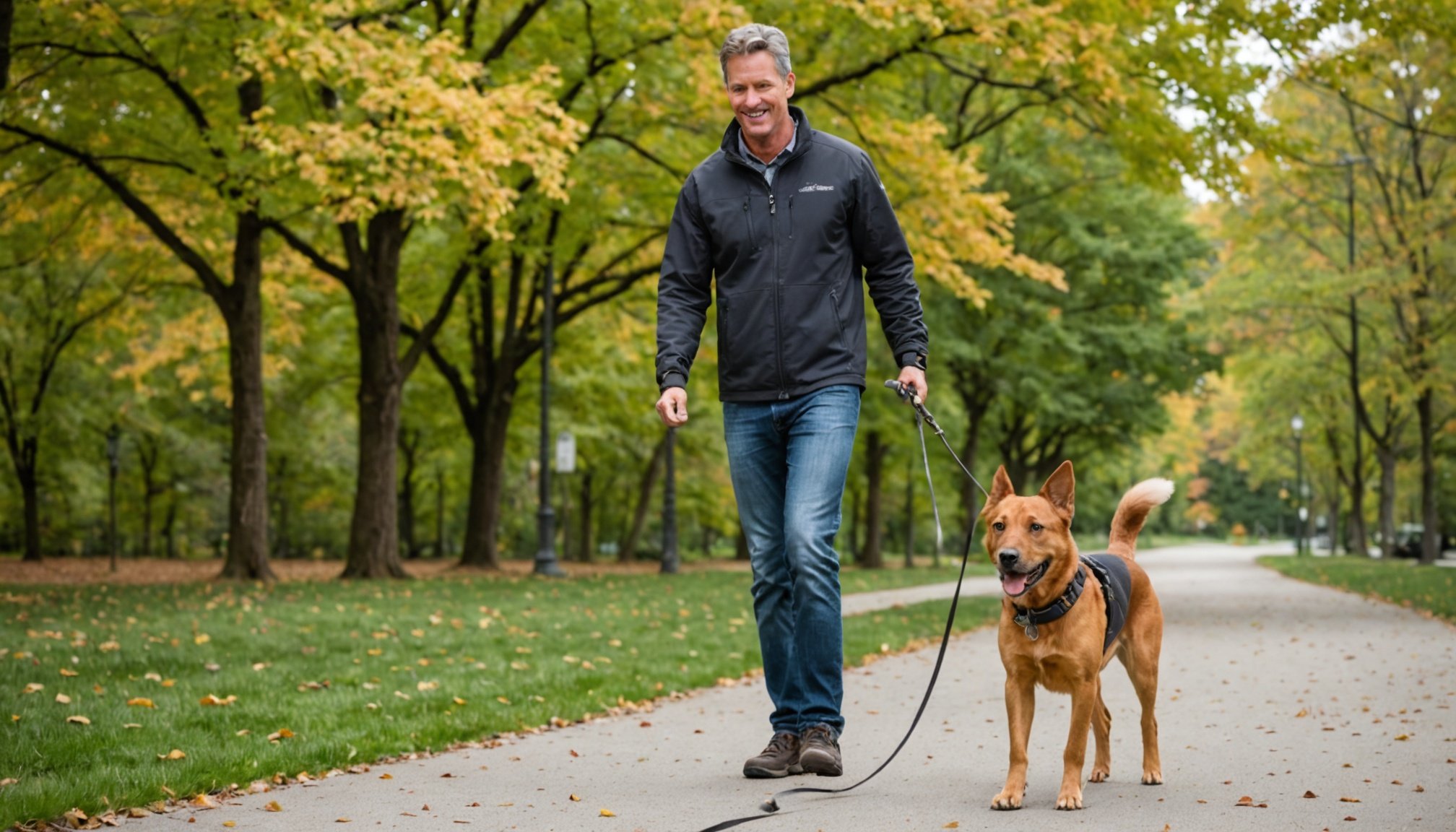Understanding Loose Leash Walking
Loose leash walking is an essential skill that enhances both dog obedience training and the quality of the walks you share with your furry friend. Loose leash walking techniques involve training your dog to walk beside you without pulling on the leash. This practice promotes harmony and reduces stress on your dog’s neck, as well as making walks more enjoyable for both of you. But why is this specific form of walking so crucial?
Implementing proper loose leash walking techniques is vital for establishing a foundation of trust and communication between you and your dog. The training benefits both parties—dogs learn self-control and focus, while owners gain confidence and assertiveness in handling their pets. It also helps in mitigating common leash walking issues, such as excessive pulling, which can be frustrating for owners and potentially harmful to dogs.
Have you seen this : Top Strategies for Seamlessly Introducing a New Bird to Your Existing Flock
Common problems while training include reluctance to follow commands or reacting to distractions such as other animals or noises. Awareness of these can set realistic expectations while underlining the importance of patience and consistency in dog obedience training. With perseverance, both pet and owner can enjoy calm, controlled, and fulfilling walks.
Equipment for Successful Training
Engaging in successful training requires the right dog training tools. Choosing the correct equipment can significantly enhance your dog’s learning experience and improve loose leash walking techniques. Among these, leashes, harnesses, and collars are fundamental.
In parallel : Top Strategies for Seamlessly Introducing a New Bird to Your Existing Flock
Best Leash Options
When selecting a leash, consider its material and length. Nylon leashes are durable and lightweight, making them suitable for dog obedience training. Opt for a standard six-foot length to allow freedom while maintaining control. Retractable leashes are not ideal for beginners, as they can encourage pulling.
Recommended Harnesses
Harnesses can promote positive behaviour by distributing pressure across your dog’s body rather than focusing on the neck. They are particularly beneficial for dogs prone to pulling. A well-fitted front-clip harness helps redirect your dog’s attention back to you, facilitating better control and teaching loose leash walking techniques effectively.
Importance of Training Collars
While some training collars can be controversial, they can be beneficial if used correctly. Collars with safety features, like quick-release mechanisms, provide additional security. Martingale collars, for example, provide a gentle correction with minimal stress, aiding in dog obedience training. Always ensure any collar fits snugly without causing discomfort. Selecting the right equipment can set a solid foundation for successful training sessions.
Step-by-Step Training Techniques
Training your dog in loose leash walking methods requires a systematic approach. By incorporating these training techniques for dogs, you can ensure an enjoyable walking experience for both you and your pet.
Basic Commands to Start Loose Leash Training
Initiating loose leash walking involves teaching basic commands such as “sit,” “stay,” and “heel.” Begin in a quiet environment to limit distractions and help your dog focus on learning. Consistency is key—use the same command words and gestures to establish a routine.
Gradual Introduction to the Leash and Collar
Introduce the leash and collar gradually. Let your dog wear the collar indoors to become accustomed to the sensation. Attach the leash and allow your dog to drag it around in a secure area, gradually taking short walks while rewarding compliance and calm behaviour.
Techniques for Achieving and Maintaining Attention
To keep your dog focused during walks, employ techniques like changing direction whenever your dog becomes distracted. Use treats or toys as incentives to reinforce positive behaviour. Teaching “watch me” or “focus” commands keeps your dog’s attention on you rather than distractions. Integrating these techniques helps solidify the foundation of loose leash walking methods, enhancing both obedience and enjoyment.
Positive Reinforcement Strategies
Reward-based training is pivotal in teaching loose leash walking techniques, tapping into successful dog motivation techniques. This approach focuses on the psychology behind rewards, ensuring your dog associates positive behaviour with gratifying outcomes.
Types of Rewards
Different rewards can cater to your dog’s unique preferences. Treats are the most common form, often being delicious and easy to administer during training. Toys serve as an engaging alternative, catering to dogs with high energy levels. Verbal praise, such as a cheerful “good dog,” reinforces positive behaviour without tangible items, fostering a deeper bond through dog obedience training.
Timing of Rewards
Strategic timing of rewards is crucial to effectively reinforce desired behaviours. Immediate reinforcement ensures the dog links the reward with specific actions or commands. This means offering a treat or praise the moment your dog exhibits the desired behaviour. Such precise timing strengthens the learning process, aligning with the principles of loose leash walking techniques.
Incorporating Praise and Encouragement
Consistent praise and encouragement maintain motivation, sustaining interest in training sessions. Complimenting your dog with an enthusiastic voice enhances the experience, promoting a cooperative attitude. Combining verbal praise with treats or toys leverages multiple dog motivation techniques, ensuring comprehensive engagement. Encouraging praise supports consistent obedience and accelerates the learning curve in dog obedience training.
Common Challenges and Solutions
Training your dog can be an adventurous journey, often sprinkled with dog training challenges. When faced with leash pulling or distractions during loose leash walking, it’s crucial to identify the underlying behavioural issues. Distractions like other pets or changing environments can lure your dog away from focus. Recognising these triggers helps tailor effective strategies.
To tackle leash pulling, employ positive reinforcement. Reward calm behaviour with treats, gradually increasing the time spent walking calmly before offering a reward. When distractions arise, redirect attention using commands like “focus” or “watch me”. Practice initially in familiar settings before gradually introducing more challenging environments.
Consistency and patience are your steadfast allies in dog obedience training. By establishing a routine, dogs learn what to expect, reducing hesitation. If challenges persist, revisiting basic commands or seeking advice from professional trainers might be beneficial. Remember, each dog learns at its pace.
Patience is key; embrace the small victories along the way. With dedication, overcoming these detours can lead to rewarding and enjoyable walks with your dog. Over time, these solutions enhance your training journey, building a strong, cooperative bond between you and your furry companion.
Success Stories and Testimonials
Real-life dog training success stories can serve as powerful motivation and guidance for those embarking on their training journey. These testimonials from dog owners highlight the transformative power of loose leash walking techniques and the significant impact on both dogs and their handlers.
Rover, a typically excitable Labrador, turned out to be a classic example of a restless walker. His owner, Emily, diligently employed reward-based training to mitigate Rover’s leash pulling. Within weeks, the pair experienced calm, enjoyable walks—a result of patient reinforcement and structured training techniques.
Another impactful tale involves Max, a German Shepherd who was initially distracted by every squirrel and fluttering leaf. Through consistent loose leash walking methods and encouragement, his owner Jack shared a powerful testimony of improved focus and their regained leisurely strolls.
Experienced trainers often share that persistence in applying dog obedience training strategies can turn potential frustration into success. They recommend starting with achievable goals and celebrating even small victories, thereby strengthening the bond between dog and owner.
Such narratives underscore the importance of perseverance and consistent application of training techniques, serving as both inspiration and guidepost for those navigating their own training challenges. Each success story reminds us that with dedication, overcoming challenges is within reach.








